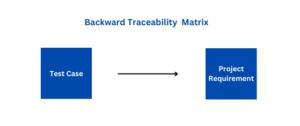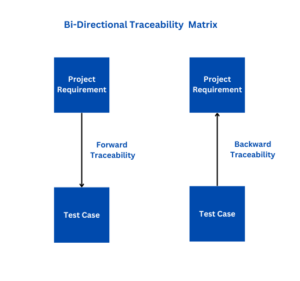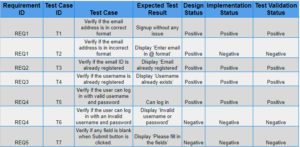Selenium Course
- 64k Enrolled Learners
- Weekend/Weekday
- Live Class
Project management tools are lifesavers for project managers as they help them plan, organize, and execute projects efficiently. Requirements Traceability Matrix is one such document that provides a centralized platform where team members can access project requirements and their test cases. This Matrix ensures that each requirement is properly validated and implemented. This blog guides you through everything you need to know about the Requirements Traceability Matrix! Let’s get started.
A Requirement Traceability Matrix (RTM) is a document that tracks the relationship between different stages of a Software development process. The data is stored as rows and columns. RTM is commonly used in software development processes for project management and quality assurance to ensure that requirements are systematically traced throughout the project lifecycle. It helps verify the status of each requirement throughout the software development phases, ensuring that the project stays aligned with its initial objectives.
In software development, once the requirements are specified by the clients, a Software Requirement Specification(SRS) document is prepared. A Requirement Traceability Matrix breaks down the SRS document into a table format and briefly describes the requirements, test cases, and their progress. In simpler words, it is a checklist to make sure the client’s requirements are met according to different test cases. Requirement Traceability Matrices will help manage the following:
There are three main types of traceability matrices based on their direction.
1. Forward Traceability Matrix
In the forward-traceability matrix, requirements are linked to the test cases in the forward direction, i.e., each requirement is mapped to the corresponding test case. Here, we can verify that all requirements are covered in test cases. It gives a view of how requirements progress through the project lifecycle. It usually starts with requirements and progresses through subsequent stages of development.
2. Backward Traceability Matrix
The backward-traceability matrix, also known as the reverse traceability matrix, is opposite to the forward-traceability matrix. Here, each test case is mapped to the corresponding requirement. It typically starts from the testing phase and goes back to the original requirements.
 3. Bi-directional traceability
3. Bi-directional traceability
A Bi-directional Traceability Matrix combines both forward and backward traceability into a single matrix. It establishes links not only from requirements to test cases (forward tracing) but also from testing and implementation back to the requirements (backward tracing). This matrix is used to make sure that all the business needs are met in the test cases.

Now that you have understood the different types of traceability Matrices, it is time to understand the key components of the Requirement Traceability Matrix.
Next, let’s create a sample Requirement Traceability Matrix for a website login module.
In a Requirement Traceability Matrix, each row represents a requirement, and the columns show the associated design, implementation, test cases, and validation status. The matrix allows for easy tracking of the progress of each requirement through the development and testing phases.

The above requirement traceability matrix is a sample for a website user login module. The email id, username, and password are required inputs from the user. The RPM validates different functional requirements of the login module. This RTM is created using an Excel sheet. Before creating the Requirements Traceability Matrix, define your objectives and have a thorough understanding of their responsibilities.
Now that you have created a Requirements Traceability Matrix in Excel let’s explore some tools that are in the market to develop a Requirements Traceability Matrix for easy project management.
Requirements Traceability Matrix (RTM) tools are software solutions designed to help manage and track the relationships between various project functionalities, such as requirements, design documents, test cases, implementation, and other deliverables. These tools facilitate the traceability of requirements throughout the entire software development life cycle. Excel is a widely used tool for creating RTMs.
Some tools that will help you plan your Requirement Traceability Matrix include:
The Requirements Traceability Matrix (RTM) holds significant importance in software testing as it ensures the thorough validation and fulfillment of all requirements throughout the project lifecycle. This blog guides you through the basics of the requirement traceability matrix, shedding light on how a simple RTM can improve the overall quality of your project and ultimately improve client satisfaction.
If you are someone who want to get started with Selenium, Check out Edureka’s Selenium certification training. This training helps you become a certified Automation Tester. The selenium testing course online helps you learn to work with various web element(s), locate strategies, perform actions on web elements, group and sequence tests, and generate reports for your test cases using TestNG.
Have a query for us? Kindly let us know in the comments section, and we’ll get in touch with you.
 Thank you for registering Join Edureka Meetup community for 100+ Free Webinars each month JOIN MEETUP GROUP
Thank you for registering Join Edureka Meetup community for 100+ Free Webinars each month JOIN MEETUP GROUPedureka.co